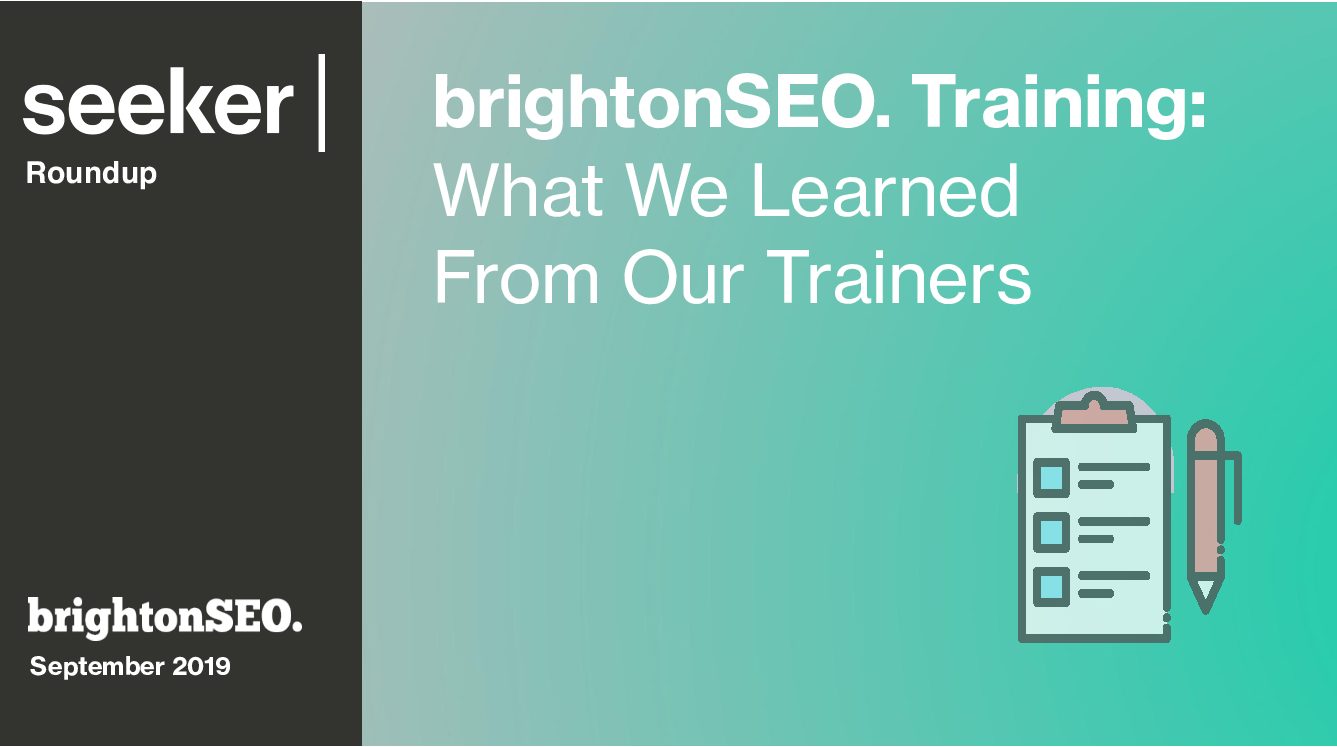
We like to learn and challenge ourselves. So, as well as the conference, a fair few Seekers attended training sessions this BrightonSEO (for anybody thinking of attending: do it). Here are some of the amazing insights and takeaways from the talented trainers.
Longtail Content Strategy with Laura Hampton (Impression)
The best way to start a longtail content strategy is with personas. Personas allow you to appeal to specific demographics, use their common language, develop campaigns for the end-user, and make content decisions based on that persona.
Once you have your personas, you can use content to support the wider customer journey/ marketing funnel. The marketing funnel is divided into four sections: awareness, interest, consideration, and intent.
You can use longtail research to target each of these stages in the marketing funnel.
- A useful exercise for coming up with suitable long-tail keywords is to pick a client, imagine their customers or users, and make a list of all the questions you think they will have about their product or service at each stage of the marketing funnel
- Once you have done all this research and have a long list of longtail keywords, plan content around each stage of the customer journey/marketing funnel for every persona
- When doing so, consider intent as this will influence the format. Consider whether the intent is informational or transactional
- When executing a content plan based on longtail keywords, start with conversion-level keywords and work your way up the levels, using related longtail keywords.
Think about product-based journeys and motivation-driven journeys. Answering these questions can help you form the basis of a content strategy based around longtail keywords.
Advanced Content Creation with Mark Johnstone
This course run by Mark Johnstone was all about idea creation: how to create stellar content ideas that will engage, entertain, and inform.
The first tip? Ask your clients what they want to get out of big asset ideas. What are they comfortable talking about, and what do they really want to talk about?
Once you have that fleshed out, go for one KPI, rather than a shopping list of KPIs: content should have one primary job and then other nice-to-have criteria.
When ideating, don’t feel the need to start with the content format, and remember that sometimes data can come before content.
- Focus on the input (the ideation process) as much as the output (content)
- Spider diagrams are a great way to ideate on a specific theme
- Thinking is a large part of your job – the deliverables will come later
- The flashiest content isn’t always the best because everyone is doing it.
SEO Auditing with Tom Pool & Sean Butcher
Tom and Sean from Bluearray delved into the world of SEO audits: a popular SEO ‘product’ for clients to buy.
Firstly, you should be aiming to get 6 to 12 months of strategy off the back of the audit, but be prepared to invest in the storytelling side too. That’s what will make your client actually invest in making the necessary changes and improvements.
The four components of an SEO audit are:
- Technical
- Keywords & Keyword gap
- Links
- Analytics.
A mini audit should take about a day, whereas a full audit may take up to ten days.
One really important point is that you have to know your auditing audience:
- Developers want problems and actions
- Marketers need long-form documents and data
- Chairmen want a high-level overview and company objectives.
As well as lots of practical advice on site crawling and auditing, there were some great points on how to best present your audit findings:
- A slideshow that directors or CEOs can sit in for the headline presentation
- They can then leave, and more detail will be provided for the marketers
- You need a good couple of hours to present and audit (preferably face-to-face)
- Sort datasheet by priority order
- Include an extra column for notes from meeting
- Also columns for benefit of implementing the change.
Digital PR for Link Building with Laura Crimmons
Firstly: thanks for Laura for providing such an engaging talk on digital PR and the best way to use media and journalists to get links.
Remember that not all links are equal. You should value links that drive traffic to your sites: this is often done through top-tier press.
National and regional press are both worth contacting. Nationals will only link if they can’t put all the data in the story, whereas regionals will link if you can provide regional angles.
Top tip: contact Group Editors of regionals and you’ll likely get published across the group.
Process for campaigns:
- SEO briefing
- PR brainstorm
- Creative brainstorm
- Strategy
- Brainstorm.
When you’re getting a new client, complete a campaign audit. See what’s been done before, review successes, and consider whether there is anything that you can refresh and re-use?
Here are some ways to vet sites as possible outreach targets:
- Quality of site
- Circulation of site
- Social following
- Amount of comments
- Spon = no-follow ratio
- Posting frequency
- Relevance.
Bad outreach:
- No personalisation
- Leading with client
- Subject line is boring
- Adding attachments.
Create content that’s new and interesting and you’ll get a link.
Copywriting for SEO with Emily Hill
CEO of Writemysite, Emily Hill knows a thing or two about copy that sparkles. Copywriting for SEO comes down to understanding your audience and their intent, as well as using clear and direct language. Writing with purpose is important.
- Simplicity is important
- Use your common sense when writing
- Tools like Quora are great for keyword and content research
- Incidentally: keywords (and links) will never die
- Use tools to learn about what your customers want to read.
It’s important to not neglect the vital insights you can get from tools like Google Analytics and the Ahrefs Content Explorer. These are your friends when it comes to understanding your audience and finding out how well your content is performing.
A good analogy that can help with copywriting is this: when people buy a drill, they are actually buying a hole in the wall.
Ecommerce SEO with Maria Camanes Fores
Maria from Builtvisible had lots of knowledge to share about ecommerce websites and ecommerce SEO.
Here are some of her top tips:
- Don’t try and do too many pages: keep page numbers minimal, but pages detailed
- Include lots of detail on product pages (without using tabs)
- Keep your Black Friday pages going and leverage fresh content and redirects where needed.
Some handy ecommerce SEO tools she mentioned were SEOMonitor and SEMrush.
Python for SEO Data Analysis with Nick Duddy
This hands-on and practical session was all about what Python is, how to use it, and how it can help improve your SEO data analysis.
Python data structures are easy to use, leverage, and adapt, and Python is helping to make data more accessible.
From data wrangling to troubleshooting, this hands-on tutorial left us with plenty of cool code to implement…
